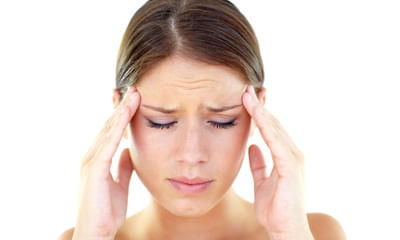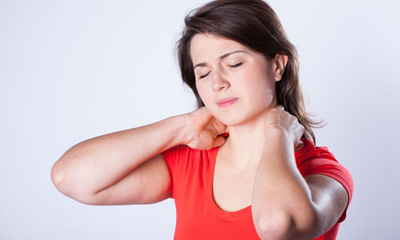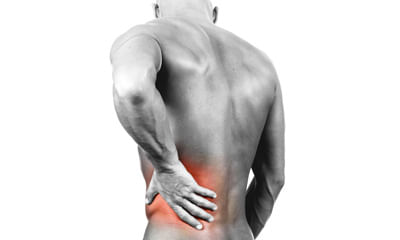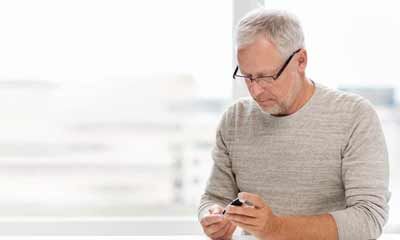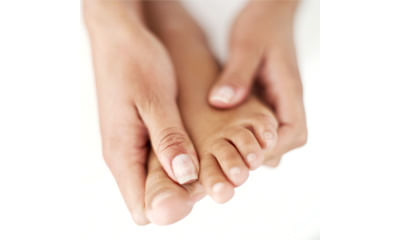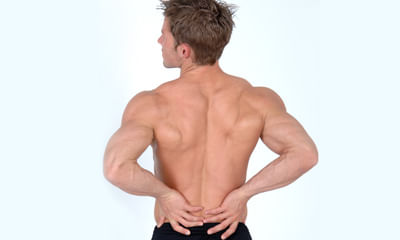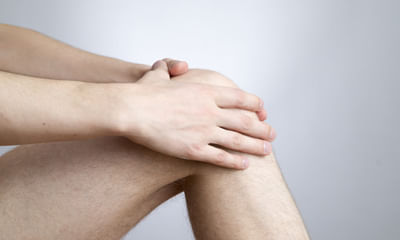Tingling In Left Forearm
Hello sir, I am preparing competitive exam but I have health issues due to 2015 accident. Problems headache, neck pain, ...
Ask Free Question
Kindly do exercises that are listed below 2. Standing extension how it helps – this standing extension helps reverse what you do on a daily basis (hunching)… since most bulging discs and herniated discs are caused by poor posture and repeated flexion of the spine (esp bending fwd in bad posture), this stretch helps push the disc back to neutral position. How to do it – begin this exercise by standing up with good posture. Now take both hands and place them on both sides of your lower back. Now with the help of your hands push your pelvis forward and extend your spine back. Follow the extension with your neck so that you end up facing the ceiling. – start with 10 repetitions and do 2-3 sets. – this one is particularly great to do when you need a break from sitting at your desk. ** this should not cause any pain. If you feel pain during it is not a good one for you. In that case, stop and try some of the other exercises below instead. 3. Half cobra pose (prone lumbar extension) how it helps – the half cobra stretch helps to push the disc material back towards the center of the inter-vertebral disc to allow for improved healing. The goal of repeated lower back extension is the “centralization of symptoms”, which basically means pain that travels down the affected leg to the foot should come back up closer to the low back – which will in turn alleviate the pain. How to do it – begin this exercise by lying on your stomach (prone position) and slowly prop yourself up on your elbows while keeping your hips in contact with the floor. – hold the prop-up position for 10-15 seconds before returning to the prone position (lying face down). – gradually increase to holding the end position for 30 seconds. Aim for 10 repetitions of this stretch. ** initially, you may not be able to tolerate this position very well, so make sure you start slowly and carefully. If there’s any pain, try a different exercise instead. 4. Full cobra pose (advanced extension) how it helps – this stretch is based on the same principle as the half cobra pose above. This advanced extension helps to push disc material back towards the center of the intervertebral disc, with the goal of alleviating pain symptoms. How to do it – once you’ve mastered the half cobra pose, you can increase the difficulty by moving to the advanced version of this stretch. Begin this exercise by lying on your stomach in the prone position (lying facing down) and slowly press up on your hands while keeping your pelvis in contact with the floor and lower back relaxed. – hold the prop-up position for 10 seconds. Aim for 10 repetitions of this stretch. – eventually try to hold this pose for longer if it feels good (20-30 seconds). ** if you feel pain during this exercise, it is not a good one for you. In that case, stop and try some of the other exercises instead. 5. Cat-cow how it helps – this is one of the most popular herniated disc exercises. By combining two yoga poses, the cat-cow stretch can help to relieve pressure on the herniated disc by opening the intervertebral disc space. It also improves mobility of the spine, which may help to relieve disc herniation pain and speed recovery. How to do it – begin this stretch on your hands and knees. Inhale and let your stomach “drop” towards the floor as you look up towards the ceiling. – follow this by exhaling and slowly rounding your spine while pressing into the floor with your hands and slightly curving your neck to look at your feet. – aim for 10 repetitions of this stretch and do 2-3 sets. How it helps – this exercise will help strengthen and stabilize your lower back and deep spine muscles. This will help you to maintain a good posture and avoid future episodes of herniated discs. How to do it: – begin on your hands and knees with your hands positioned under your shoulders and knees positioned under your hips. – raise your left arm and reach it forwards until it is aligned with your torso; at the same time, kick your right leg backwards until is it aligned with your torso. – hold this position for 2-3 seconds before slowly returning to the starting position. – repeat with your right arm and left leg. – alternate sides for 10 repetitions and do 2-3 sets. ** ensure that your head, neck, and back maintain a neutral alignment to minimize stress on your neck. Plank: how it helps – just like the bird dog, this “core” exercise will help bring your pelvis into right position by strengthening the deep spinal muscles and glutes (butt muscles). How to do it – begin lying on your stomach with your forearms against the mat. – engage your core and lift your body so that you are resting on your forearms and toes. – start with 10 second holds and work up to 30 second holds, do 2-3 sets. ** ensure to keep your back straight throughout the entire exercise – spine in neutral position. Thoracic expansion if you’re using a chair, sit facing forward and allow your upper body to fall over the back of the chair. Extend your arms above your head for a deeper stretch. Hold either position for 10 seconds and release. Repeat 3 times. Can tight neck muscles cause vertigo. Your inner ear might not be the culprit. Vertigo is the technical name for dizziness, especially the type where it feels like the room, or the patient, is spinning. Theneck structures most likely to cause vertigo are a muscle called the sternocleidomastoid (scm for short) and the uppermost joints of the spine shin pain 1.Keep your legs elevated. 2.Use ice packs to reduce swelling. Shop for cold compresses. 3.Take an over-the-counter anti-inflammatory, such as ibuprofen (advil) or naproxen sodium (aleve). Shop for ibuprofen and naproxen sodium. 4.Wear elastic compression bandages. 5.Use a foam roller to massage your shins. Finger stretch 1.Place your hand palm-down on a table or other flat surface. 2.Gently straighten your fingers as flat as you can against the surface without forcing your joints. 3.Hold for 30 to 60 seconds and then release. 4.Repeat at least four times with each hand. Scapular dyskinesis technique #1: overhead wall rollout this is a great exercise for retraining scapulohumeral rhythm and activating the serratus anterior as well as integrating shoulder flexion with core stability. 1.Stand leaning against a wall with an ab-wheel in your hands 2.Protract your scapulae 3.Slowly roll the ab-wheel up the wall and ensure you’re shrugging your shoulders to elevate your scapulae as your arms rise up while keeping tension in your core to avoid lumbar extension 4.Roll back down slowly and with control and return to the initial position. 5.Breathe naturally throughout the movement scapular dyskinesis technique #2: supine serratus activator this activation technique will help reset your scapulae in the correct position, while reactivating the inhibited posterior muscles of your shoulder. 1.Lay on your back with legs bent, feet flat and arms by your side 2.Bend your elbows so your fingers are pointing up towards the sky with palms facing together 3.Drive your elbows into the ground to activate the lats and posterior deltoids without trying to pinch your scapulae together 4.Picture your chest opening and the medial border of the scapulae moving up into your body and hold for 5 seconds 5.Relax briefly and repeat.
Im 22 year old female. I have been experiencing constant pain in the region above left buttock. Some times the pain is s ...
Ask Free Question
Back pain can affect people of any age, for different reasonsas people get older, the chance of developing lower back pain increases, due to factors such as previous occupation and degenerative disk disease. Lower back pain may be linked to the bony lumbar spine, discs between the vertebrae, ligaments around the spine and discs, spinal cord and nerves, lower back muscles, abdominal and pelvic internal organs, and the skin around the lumbar area. •acute pain starts suddenly and lasts for up to 6 weeks. •chronic or long-term pain develops over a longer period, lasts for over 3 months, and causes ongoing problems. Home advise: •resting from strenuous activity can help, but moving around will ease stiffness, reduce pain, and prevent muscles from weakening. •applying heat, ice, ultrasound, and electrical stimulation — as well as some muscle-release techniques to the back muscles and soft tissues — may help alleviate pain. •as the pain improves, the physical therapist may introduce some flexibility and strength exercises for the back and abdominal muscles. Techniques for improving posture may also help. •the patient will be encouraged to practice the techniques regularly, even after the pain has gone, to prevent back pain recurrence. Regular exercise helps build strength and control body weight. Guided, low-impact aerobic activities can boost heart health without straining or jerking the back. Before starting any exercise program, talk to a health care professional. There are two main types of exercise that people can do to reduce the risk of back pain: •core-strengthening exercises work the abdominal and back muscles, helping to strengthen muscles that protect the back. •flexibility training aims at improving core flexibility, including the spine, hips, and upper legs. We suggest you to wear lumbosacral corset (belt) which is available at our clinic. If you want you can buy from us, if you are far away from chennai we can send you by courier. The reason why we are conveying you to buy from us is we can demonstrate over the videocall (using whatsapp) and also we can monitor you throughout when to wear it and how long to wear it. And also if you find any difficulty wearing the brace you can also revert back to us for few more suggestions and we can propose you good solution how to go about it. Uses of lumbosacral corset (belt) a lumbosacral corset adds pressure to the intra-abdominal area. This adds stability to the spine. It is prescribed to people suffering from moderate to severe pain. Other benefits of using a lumbar spine belt are: 1.helps in a certain degree of immobilization of facet joints. 2.reduces pain to allow continuation of normal activities. 3.speeds up the healing process. 4.the pressure exerted by a lumbar spine belt helps in stretching the erector spine muscles. 5.this belt can also be used to support the lower back while exercising. Ohelps prevent rolling oprovides stability to lumbar and sacral regions of the back ocan be used when performing actions like lifting and handling heavy items ocan also be used when playing sports orestricts back movement to aid treatment of back problems do’s and don’ts sitting do: • sit as little as possible and then only for short periods. • place a supportive towel roll at the belt line of the back especially when sitting in a car. • when getting up from sitting, keep the normal curves in your back. Move to the front of the seat and stand up by straightening your legs. Avoid bending forward at the waist. • try to keep the normal curves in your back at all times. Don’t: • do not sit on a low soft couch with a deep seat. It will force you to sit with your hips lower than your knees and will round your back. You will loose the normal curve in your back. • do not place your legs straight out in front of you while sitting (e.g. Sitting in the bath tub). Standing do: • if you must stand for a long period of time, keep one leg up on a foot stool. • adapt work heights. Don’t: • avoid half bent positions. Lifting avoid lifting if you can. Do: • use the correct lifting technique. Keep your back straight when lifting. Never stoop or bend forward. Stand close to the load, have a firm footing and wide stance. Kneel on one knee, keeping the back straight. Have a secure grip on the load and lift by straightening your knees. Do a steady lift. Shift your feet to turn and do not twist your back. Don’t: • do not jerk when you lift. • do not bend over the object you are lifting. Lying do: • sleep on a good firm surface. • if your bed sags, use slats or plywood supports between the mattress and base to firm it. You also can place the mattress on the floor, a simple but temporary solution. • you may be more comfortable at night when you use a pillow for support. Don’t: • do not sleep on your stomach unless advised to do so by your doctor or physical therapist. Bending forward do: • keep the natural curves of your back when doing these and other activities: making a bed, vacuuming, sweeping or mopping the floor, weeding the garden or raking leaves. Coughing and sneezing do: • bend backwards to increase the curve of your back while you cough or sneeze. Driving a car do: • drive the car as little as possible. It is better to be a passenger than to drive yourself. • move the seat forward to the steering wheel. Your seat must be close enough to the wheel to keep the natural curves of your back. If your hips are lower than your knees in this position, raise yourself by sitting on a pillow. Exercises for low back pain safety guidelines • an increase in your low back pain can be expected with these exercises. This is acceptable as long as your leg symptoms are not increasing. • if while doing these exercises, your pain worsens or you have new pain or symptoms, stop the exercises and discuss your symptoms with your doctor or physical therapist. • stop exercising and let your doctor or physical therapist know right away if you have any change in your bowel or bladder control or any increase in weakness in your leg or foot. Exercises ‰ •press-ups: keep your back and buttocks relaxed and use your arms to press up. Concentrate on keeping your hips down and push up your upper body as high as possible. •double knee to chest: grasp both your knees with your hands and pull toward your shoulders. Hold the stretch for 1 second. Let your knees return, but keep them bent at arms length. ‰ •lumbar spine stretches: lie on your back. Bring your knees towards your chest. Rotate your knees towards the pain. •side-lying position: lie on your side and face forward. Have both arms straight in front and bend your knees. Turn your head as you move your top arm across your body as far as you can. Keep your arm in place and turn your head back to the starting position. Look back again and turn your head farther if you can. Bring your head and arm back to the starting position. Relax and repeat 10 times on each side. •hamstring stretch: lie on your back with your legs out straight. Raise your leg up and put your hands around the upper leg for support. Slowly straighten the raised knee until you feel a stretch in the back of the upper leg. Hold, then relax and repeat 10 times on each leg. •standing arch: stand with your feet apart and hands on the small of your back with fingers pointing backwards. Bend backwards at the waist, supporting the trunk with your hands. Keep your knees straight. Hold for 5 seconds. Repeat 3 to 5 times. Side glides: stand at a right angle to the wall about 2 feet o eliminate your pain improve your muscular endurance and strength attain better posture, balance, body awareness and co-ordination improve your balance and flexibility learn to lift properly. posture when standing: make sure you have a neutral pelvic position. Stand upright, head facing forward, back straight, and balance your weight evenly on both feet. Keep your legs straight and your head in line with your spine. Posture when sitting: a good seat for working should have good back support, arm rests and a swivel base. When sitting, try to keep your knees and hips level and keep your feet flat on the floor, or use a footstool. You should ideally be able to sit upright with support in the small of your back. If you are using a keyboard, make sure your elbows are at right-angles and that your forearms are horizontal. Shoes: flat shoes place less of a strain on the back. Driving: it is important to have proper support for your back. Make sure the wing mirrors are properly positioned so you do not need to twist. The pedals should be squarely in front of your feet. If you are on a long journey, have plenty of breaks. Get angle. Out of the car and walk around. Bed: you should have a mattress that keeps your spine straight, while at the same time supporting the weight of your shoulders and buttocks. Use a pillow, but not one that forces your neck into a steep.
I am 30 years old adult. I have back pain as well as tingling sensation in my hand limbs leg and it happens frequently w ...
Ask Free Question
Get your thyroid profile, cbc, blood sugar fasting checked from some lab. Since when r you having this?What r other symptoms that you r experiencing? By doing what like walking, exertion, eating or empty stomach- it increases or decreases in intensity. For how much time it remains? Is there stiffness also? Below are exercises that strengthen the lower back and help manage lower back pain: 1. Bridges—lie on the ground and bend the knees, placing the feet flat on the floor hip-width apart. Press the feet into the floor, keeping the arms by the sides. Raise the buttocks off the ground until the body forms a straight line from the shoulders to the knees. Squeeze the buttocks with the shoulders remaining on the floor. Lower the buttocks to the ground and rest for a few seconds.Repeat 15 times and then rest for 1 minute.Do 3 sets of 15 repetitions.2. Knee-to-chest stretches— lie on the back on the floor. Bend the knees, keeping both feet flat on the floor. Use both hands to pull one knee in toward the chest. Hold the knee against the chest for 5 seconds, keeping the abdominals tight and pressing the spine into the floor. Return to the starting position.Repeat with the opposite leg.Repeat with each leg 2–3 times twice a day. 3. Lower back rotational stretches—lie back on the floor with bent knees and feet flat on the ground. Keeping the shoulders firmly on the floor, gently roll both bent knees over to one side. Hold the position for 5–10 seconds. Return to the starting position. Gently roll the bent knees over to the opposite side, hold, and then return to the starting position. Repeat 2–3 times on each side twice a day. 4. Draw-in maneuvers— lie back on the floor with knees bent and feet flat, keeping the arms by the sides. Breathe in deeply. While breathing out, pull the bellybutton toward the spine, tightening the abdominal muscles and keeping the hips still. Hold the position for 5 seconds. Repeat 5 times. 5. Pelvic tilts— lie back on the floor with knees bent and feet flat, keeping the arms by the sides. Gently arch the lower back and push the stomach out. Hold for 5 seconds, then relax. Flatten the back and pull the bellybutton in toward the floor. Hold for 5 seconds, then relax. Increase the number of repetitions daily, building up to 30. 6. Lying lateral leg lifts— lie on one side with the legs together. Keep the lower leg slightly bent. Draw the bellybutton into the spine to engage the core muscles. Raise the top leg about 18 inches, keeping it straight and extended. Hold the position for 2 seconds. Repeat 10 times. Turn onto the other side of the body and repeat, lifting the other leg. Perform 3 sets on each side. 7. Cat stretches— get onto the hands and knees with the knees hip-width apart. Arch the back, pulling the bellybutton up toward the spine. Slowly relax the muscles and allow the abdomen to sag toward the floor. Return to the starting position. Repeat 3–5 times twice a day. 8. Supermans— lie face down on the ground and stretch both arms out in front of the body, keeping the legs stretched out and flat on the ground. Raise both the hands and feet, aiming to create a gap of about 6 inches between them and the floor. Try to pull in the bellybutton, lifting it off the floor to engage the core muscles. Keep the head straight and look at the floor to avoid neck injury. Stretch the hands and feet outward as far as possible. Hold the position for 2 seconds. Return to the starting position. Repeat 10 times. For this homeopathic treatment is very effective consult online with details.
My father is diabetic and has neuropathy issue and uses to stick to walk outside home, so left leg has less sensation. I ...
Ask Free Question
Prevention of neuropathy: 1. Avoid alcohol consumption and cigarette smoking. 2. Maintain ideal body weight/bmi (body mass index) 3. Lifestyle changes: daily exercises (>30 minutes per day) or brisk walking or swimming; avoid prolonged sitting or standing (>30 minutes). 4. Food/diet should have following components: •green vegetables e.g. Spinach, fenugreek leaves (methi), radish, etc •coloured vegetables e.g. Tomato, carrot, capsicum (green/red), ladies-finger (bhindi) •milk products e.g. Milk, buttermilk, curd, cheese (paneer) •protein-rich foods e.g. Fish, egg, chicken, pulses (daal) •fibre-rich foods e.g. Bran, oats, brown-rice •fruits e.g. Apple, orange, guava, papaya, pomegranate, berries 5. Blood sugar control (in diabetics) 6. Care of feet: •regular inspection of feet (with mirror) •comfortable, well-fitted shoes •regular consultation with a podiatrist •treatment of wounds, foot deformities 7. Adequate sleep 8. Warm water bath (increases blood flow to the affected area) treatment: •consult pain medicine specialist. •neuropathic painkillers e.g. Amitriptyline, pregabalin, gabapentin, capsaicin, duloxetine, etc. •vit. B12 supplements, anti-oxidants, multi-vitamins. •transcutaneous electrical nerve stimulation (tens) •acupuncture •relaxation and yoga •neural prolotherapy a burning sensation in your feet may be caused by nerve damage in the legs, also called neuropathy. Although many medical conditions can cause burning feet, diabetesis the most common. Most burning feet treatments focus on preventing further nerve damage and reducing pain. Causes of burning feet most often, neuropathy is the cause of burning feet. Damaged nerve fibers are more likely to become overactive and misfire. The damaged nerves send pain signals to the brain even though there is no wound. In most people with neuropathy, the leg nerves become damaged first. These people often have tingling and numbness in the feet as well. Many people complain that their feet are overly sensitive to touch (hyperesthesia) and can have varying degrees of burning pain. It can range from mild to disabling. Diabetes and alcohol abuse are by far the most common causes of neuropathy in the legs. Many other conditions can cause neuropathy or a burning sensation in the feet: besides neuropathy, infections and inflammation of the feet can also cause a burning sensation. The most common of these is athlete's foot, an infection of the skin caused by fungus. Peripheral artery disease (pad) also commonly causes burning feet. The poor circulation of blood to the feet may frequently cause pain, tingling, and burning feet, especially while walking. •chronic kidney disease (uremia) •small fiber neuropathy •vitamin deficiency (vitamin b12, folate, and occasionally vitamin b6) •alcohol abuse •low thyroid hormone levels (hypothyroidism) •lyme disease •hiv/aids •amyloid polyneuropathy •drug side effects, including chemotherapy drugs, vitamin b6 overdose, hiv medicines, amiodarone, isoniazid, metformin, and others •erythromelalgia •heavy metal poisoning (lead, mercury, arsenic) •vasculitis (inflammation of bloodvessels) •sarcoidosis •guillain-barre syndrome (gbs) •chronic inflammatory demyelinating polyneuropathy (cidp) •always use the footwear of proper fitting and which is comfortable. •always use socks. Never use shoes without socks. •after a long day work, it is advisable to stretch and also to ice your feet. •provide rest to your feet as much as you can. •avoid the use of alcohol or any narcotic items. •acupuncture or magnetic therapy shall be done whenever possible to keep the nerves active. •follow all the instructions as given by the doctor. Radiculopathy, also commonly referred to as pinched nerve, refers to a set of conditions in which one or more nerves are affected and do not work properly (a neuropathy). This can result in pain (radicular pain), weakness, numbness, or difficulty controlling specific muscles.[1] in a radiculopathy, the problem occurs at or near the root of the nerve, shortly after its exit from the spinal cord. However, the pain or other symptoms often radiate to the part of the body served by that nerve. For example, a nerve root impingement in the neck can produce pain and weakness in the forearm. Likewise, an impingement in the lower back or lumbar-sacral spine can be manifested with symptoms in the foot. The radicular pain that results from a radiculopathy should not be confused with referred pain, which is different both in mechanism and clinical features. This should be due to the sciatic nerve compression in the right side probably close to your l5 vertebrae. It can also be due to the strain on the left leg, try wearing mcr chappals which would help you to get relieved from pain. Juice helps you to get cleansed with toxins. Ginger in general is good for joint pain and honey / black pepper helps you to get rid out of toxins quickly increase rom- free active exercises of lumbar spine. Pelvic tilting forward, backward in crook lying, quadriped, sitting and standing. Mobilization- restoration of intersegmental mobility by accessory pressure enables the patient to regain full functional painfree movement.
My entire right arm hurts and feels tingly when I move it. When I type, my forearm up to the underside of my palm hurts, ...
Ask Free Question
It can be cervical vertebrae problem.. You can consult me through Lybrate for homoeopathic treatment. Till.then take Nux Vomica 30 one dose..
For last few days I observe that my left forearm gets senseless often, sometimes with mild pain also. Lam 66 and DM2 on ...
Ask Free Question
It could be peripheral neuropathy which is common in Diabetes. Also heart issue could be there. Make sure you do ECG and 2d echo to check if your heart function is normal.
I am 50 years old left hand fingers are feeling numb from 6 to 7 hours what should I do? ...
Ask Free Question
Pressure upon the arm nerves or vessels causing numbness, tingling or temporary paralysis of the arm may result from: Sleeping with the hand under the head Sitting with the arm hanging over the back of a chair Wearing straps or carrying a bag or rucksack Inflated cuff during measuring blood pressure Raising the Arms Above the Level of the Heart Keeping the hand (s) above the level of the heart during work or sleep can prevent appropriate blood perfusion of the hands, and cause numbness, tingling or partial paralysis of the hand (s) within few minutes. Cold In cold weather, narrowing of the arteries in the hands and fingers can prevent appropriate blood supply and thus numbness, tingling, pain or temporary paralysis of the hands and fingers. DISORDERS OF THE NECK (CERVICAL) SPINE Cervical Disk Syndrome Degenerative disc disease (DDD) or injury, like hyper-extension injury in car accidents (head moves rapidly toward the back), can result in bulging or herniated disc (s) pressing upon the cervical (neck) spinal nerves, thus causing symptoms of cervical disc syndrome: Position/movement dependent pain, tingling or numbness in the neck, shoulders, upper back, arm, hand or fingers (when the roots of cervical spinal nerves are compressed) Stumbling gait, difficulty with fine hand moves, tingling in the body or legs (when the cervical spinal cord is compressed) Symptoms can appear immediately after the injury, or develop slowly over the weeks or months. Diagnosis is made by a CT or MRI of the neck spine. Therapy includes immobilization, cold therapy followed by heat therapy, cervical traction, analgesics, muscle relaxants, physical therapy or surgical decompression of the nerve roots or spinal cord. Cervical Spondylosis Cervical spondylosis is an age-related deformation of the cervical spine; deformed vertebra or discs can press upon the spinal cord or nerve roots in the neck and cause chronic symptoms, like in the cervical disc syndrome (see above). INJURIES Disorders of the Brachial Plexus The brachial plexus is formed by the cervical nerves C5-C8 and thoracic nerve Th1. The plexus extends from the lower part of the neck to the armpit. From brachial plexus all main nerves to the arm (axillary, musculocutaneus, ulnar, radial, and median nerve) arise. Brachial Plexus Injuries Most of brachial plexus injuries usually occur in car, motorcycle and sport accidents, during birth, or in bullet or knife injuries. Symptoms and prognosis depend on the nerves involved and extent of an injury: nerve stretching, scar tissue (neuroma), partial or complete nerve rupture or tearing of the nerve from the spinal cord. A limp or paralyzed arm, severe pain and numbness, especially in the neck and shoulders, and weak arterial pulses in the arm are main symptoms. Some brachial plexus injuries may heal without treatment. Many children who are injured during birth improve or recover by 3 to 4 months of age. Treatment of brachial plexus injuries includes physical therapy and, if necessary, surgery. Thoracic Outlet Syndrome Thoracic outlet is the space between the collar bone (clavicle), first rib and corresponding ligaments through which nerves and vessels travel from the base of the neck toward the armpit. Thoracic outlet syndrome (TOS) results from a compression or extension of the subclavian artery or vein, or brachial plexus (nerves), commonly occurring in motorbike accidents, athletes, swimmers, weight lifters, etc. Symptoms include: Muscle wasting at the base of the thumb, numbness, feeling of pins and needles, or pain in the shoulder, armpit, arm or hand (when nerves are compressed) Pale, cool arm with weakened arterial pulse in the arm, numbness and pain (when vessels are compressed) Radiation-Induced Brachial Plexopathy Radiation-induced damage of the brachial plexus can follow radiotherapy of the chest, axillary region, thoracic outlet or neck. Symptoms may appear months to years after radiation therapy and include numbness, swelling, weakness or pain in the arm. Broken Shoulder Blade Shoulder blade (scapula) is the bone in the upper back that connects the collar bone (clavicle) and arm bone (humerus). Broken shoulder blade, usually from a car or motorbike accident, can result in pain, swelling, bruising or deformation of the shoulder blade area, and weakness, numbness or tingling in the shoulder or arm. Broken Arm, Wrist, Hand or Finger Symptoms of broken arm (the arm bone â humerus, elbow, and bones of the forearm â radius and ulna) include: Severe pain increasing with arm movement Obvious deformity, swelling, tenderness and bruising over the site of bone fracture Stiffness or inability to move your arm, hand or finger Weakness, numbness or tingling in the arm, hand or fingers Cubital Tunnel Syndrome or Ulnar Neuropathy The ulnar nerve arises from the brachial plexus in the neck and travels under the collar bone, downside along the inner side of the upper arm, behind the inner part of the elbow (Latin cubitus), where it can be felt as a âfunny boneâ and then down to the wrist, hand and little and ring finger. Ulnar nerve entrapment usually results from an elbow injury or constant pressure upon the elbow, like in cyclists or typists. Symptoms, known as cubital tunnel syndrome, include: Pain on the inner side of the elbow or electric shock sensation after touching the elbow The hand, ring and little finger are numb and falling asleep, especially after bending the elbow Limited movements of the ring and little finger (âhandlebar palsyâ in cyclists) Hand (on the little finger side) sensitivity to cold Prevention of ulnar nerve entrapment is by avoiding excessive elbow use. Treatment includes special arm exercises, anti-inflammatory drugs, like ibuprofen, and wearing an elbow splint. DISORDERS OF THE SPINAL CORD AND BRAIN Multiple Sclerosis Multiple sclerosis is a disease of an uncertain cause affecting the nerve tissue of the spinal cord, brainstem or brain. Symptoms can appear suddenly or gradually, âtravelâ among various body parts and include: numbness or tingling in one or both arms (or any other body part), blurred or double vision or blindness, weak or paralysed limbs, problems with urinating or defecating, difficulty maintaining balance, tiredness, etc. Symptoms can last from few weeks to several months, disappear completely and appear again, and, in general, worsen with time. Diagnosis is with MRI of the brain and spinal cord, and examination of cerebrospinal fluid obtained by lumbar punction. Apart from treating symptoms, there is no treatment for multiple sclerosis at the time. ACUTE BRACHIAL NEURITIS Acute brachial neuritis is a rare, supposedly autoimmune inflammation of brachial plexus, occurring at any age, but primarily in young men. Symptoms include severe pain in the upper arms and shoulders, followed by numbness and weak reflexes; the disorder resolves in few months on its own. WRIST DISORDERS Carpal Tunnel Syndrome (CTS) Carpal tunnel syndrome (Latin carpus = wrist) is a painful condition of the wrist, hand and fingers, caused by repetitive use of the wrist, or swelling of the tissues in the wrist, resulting in a pressure upon the median nerve. CTS is a common problem in assembly line workers, computer workers, musicians, mechanics, tennis players, etc. Bone spurs in rheumatoid arthritis, or fluid in hypothyroidism, kidney disease or menopause may also press on the median nerve. Symptoms usually start gradually and include: Tingling or numbness in the thumb, index, middle and ring finger and related part of the hand Pain in the wrist, palm or forearm Difficulty grasping small objects or gripping Hand pain at night Ganglion Cyst Ganglion cyst (Greek ganglion = tumor, cyst = fluid filled sac) is a soft lump, usually appearing on the back of the hand in some people between 20-40 years of age. It is a noncancerous fluid filled sack arising from the tendon sheets or capsule of the joint from an unknown reason. Ganglion cysts may not be always seen from the outside. Gymnasts often have them. Symptoms include: A soft lump or lumps of various size (may exceed an inch), on the back of the hand, inner side of the wrist, base of the finger, or on the last finger joint. Pain or numbness in the wrist, hand or finger (s) DISORDERS OF FINGER ARTERIES Raynaudâs Disease Raynaudâs disease is a painful finger condition due to spasms in the finger arteries. Disease may also affect toes or, rarely, nose, ears, lips and nipples. The cause is not known. Symptoms are triggered by cold (even short term cold like taking something from a freezer) or strong emotions, and appear in the following sequence: Fingers (one, more or all in one or both hands) become pale, numb or cold due to lack of blood flow, then bluish due to a lack of oxygen, then red, with throbbing pain and tingling as blood returns to the affected area. Attacks can occur daily, weekly or occasionally and can last from less than a minute to several hours, usually about 15 minutes. Different areas can be affected at different times. Severe, although rare, attacks can result in finger sores or tissue death (gangrene). Raynaudâs Phenomenon Raynaudâs phenomenon is a term used for the same finger symptoms as in Raynaudâs disease, when the cause is known. Causes include: connective tissue diseases, like scleroderma, systemic lupus erythematosus (SLE), Sjögrenâs syndrome, dermatomyositis, and polymyositis, carpal tunnel syndrome, obstructive arterial disease, anti-hypertensive drugs, ergotamine (used for treating migraine), chemotherapeutic medications, etc. In workers exposed to vinyl chloride, using vibrating tools, typists and pianists, Raynaudâs phenomenon also commonly occurs. DIAGNOSIS OF ARM NUMBNESS OR TINGLING History of arm numbness. Knowing an exact time course of tingling or numbness, and eventual arm weakness, head or legs involvement, history of arm or neck injuries, repetitive elbow or wrist use, reactions to cold, hypothyroidism, diabetes, menopause may give a strong evidence about the cause. Neurological examination. Testing of sensitivity of a particular arm dermatome can reveal which nerves are involved. Imaging. X-ray may reveal arthritis in the neck spine, or a broken arm bone. Myelography can reveal herniated disc or narrowed spinal canal. MRI and CT show soft tissues like tumors. Electromiography (EMG) and nerve conduction studies can show the nature of the nerve damage. Together with imaging they are important to evaluate the extent of brachial plexus injury. Blood tests can reveal diabetes, abnormalities in serum levels of sugar (diabetes), calcium, potassium, sodium, magnesium, vitamins B6 or B12, thyroxine (hypothyroidism), sex hormones (menopause). Cold simulation test can reveal Raynaudâs disease or phenomenon. TREATMENT OF ARM NUMBNESS OR TINGLING Firstly, the cause of numbness should be treated if possible. Non-steroid anti-rheumatic drugs like ibuprofen, or antidepressants, may relieve pain and numbness.
I have desk job last six months I have a severe pain in my back what can I do for this please give me solution and I hav ...
Ask Free Question
Apply hot fomentation twice daily. Avoid bending in front. Postural correction- sit tall, walk tall. Extension exercises x 15 times x twice daily - lying on tummy, take left arm up for 3 seconds, then bring it down, right arm up for 3 seconds, bring down. Bring right leg up, hold for 3 seconds, bring it down. Then right leg up and hold for 3 seconds and bring it down. Repeat twice a day- 10 times. Bhujang asana -- lie flat on your stomach, keeping the palms out, bend the neck backward, take a deep breath and while holding it for 6 seconds, raise the chest up. Release breath and relax your body. Repeat the exercise 15 times twice daily. Core strengthening exercises- straight leg raised with toes turned outward, repeat 10 times, twice a day.
I am 21 years old I have a severe pain in my left leg from past 2 years and the pain is not continues. The pain comes ba ...
Ask Free Question
It seems you are suffering from nerve compression. Whenever a back nerve compresses or impinge it creates pain over its nerve root. After looking to your pain I am recommending you something: Precautions: 1. Avoid forward bending, if required then bend your knees first and then bend forward. 2. Avoid weight lifting. 3. Sit in chairs or car seats with proper back support. 4. Place pillow under your legs while sleeping or can opt sidelying position for sleep. 5. Get enough vit d from sun as vit d keep bones strong including spine and other bones. 6. Drink plenty of water to enhance the intervertebral disks. 7. Avoid prolonged standing. 8. Change your sitting position every 15 minutes so that it does not pain. If possible visit some neuro-physio who can give you several modalities like SWD, IFT, traction etc to cure the pain. Along with it we have a special program designed in case of sciatica that is Butler’s mobilisation and Mckenzie exercises which a physio gives with the proper technique to get cure from disease. I understand your pain so I am suggesting you the following treatment that you can take at home and can get some relief from pain and discomfort. Treatment: 1. Use of Cold packs- Sometimes piriformis muscle gets tight which cause impingement of sciatic nerve leading to tingling and numbness sensation down into the leg. So ice massage can be given over the area of piriformis muscle or the entire back for 15 min. Once done with cold therapy take rest for 2-3 min to relax the muscles. 2. Since the pain is radiating you can do some below mentioned exercises which will give you immediate relief from pain if done correctly. A) Lie on bed on your stomach gently push up with your arms, resting on your forearms. Hold for 5 secs. Now slightly stretch your back muscles and count till 10 and relax. You might feel a slight pain initially but do not worry. Repeat it 15 times. B) Now that pain must have gone. And now you can push up onto your hands fully. Slowly lower down back to floor. Perform this atleast 15 times. Again a slight pain will be there initially. Once you will complete this exercise program your pain will be relieved right away. If pain is severe while doing the exercise then stop doing the exercise and immediately consult some physio to take care further. Other exercises that can be done in sciatica pain are: 1. Straight leg raising 2. Knee to chest. 3. Hamstring stretch. 4. Back extensors stretches and strengthening. 5. Gluteal stretch. All the above can be done for 10-15 times with the hold (stretch) time of 5 -6 secs Make sure to perform the exercises correctly which will give you relief from your pain and strengthen your muscles. Good Luck and Get Well Soon.

